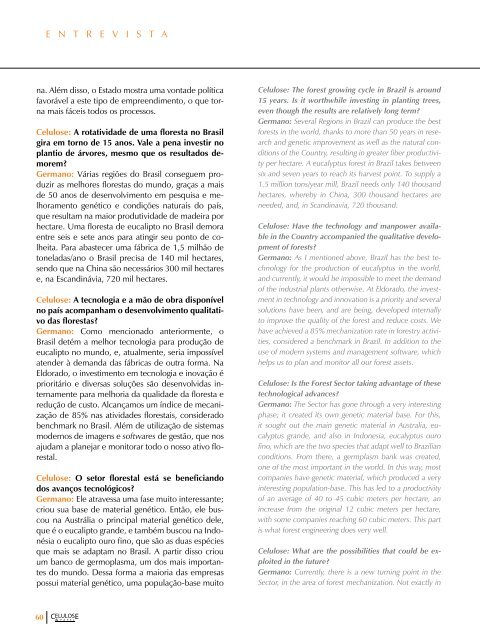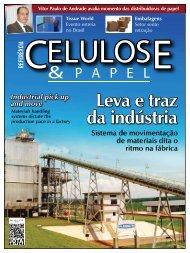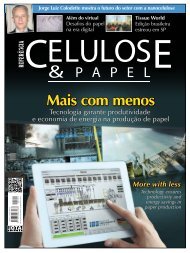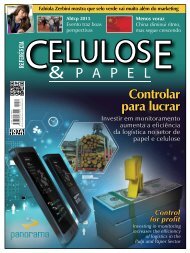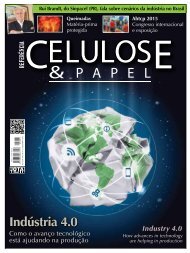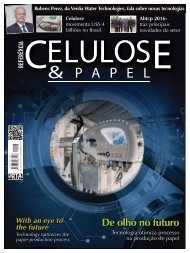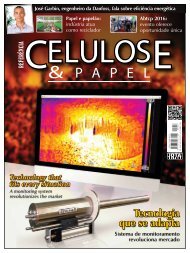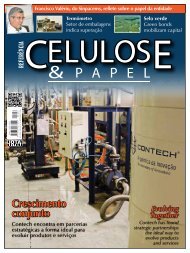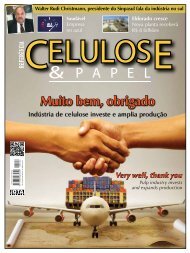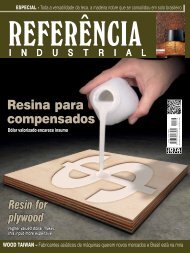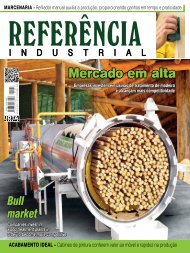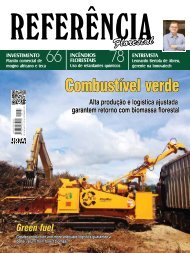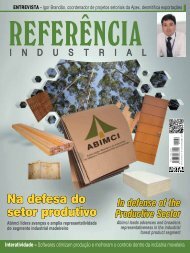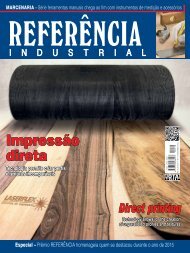Junho/2016 - Celulose e Papel 25
Visitantes - Grupo Jota Comunicação
Visitantes - Grupo Jota Comunicação
You also want an ePaper? Increase the reach of your titles
YUMPU automatically turns print PDFs into web optimized ePapers that Google loves.
E N T R E V I S T A<br />
na. Além disso, o Estado mostra uma vontade política<br />
favorável a este tipo de empreendimento, o que torna<br />
mais fáceis todos os processos.<br />
<strong>Celulose</strong>: A rotatividade de uma floresta no Brasil<br />
gira em torno de 15 anos. Vale a pena investir no<br />
plantio de árvores, mesmo que os resultados demorem?<br />
Germano: Várias regiões do Brasil conseguem produzir<br />
as melhores florestas do mundo, graças a mais<br />
de 50 anos de desenvolvimento em pesquisa e melhoramento<br />
genético e condições naturais do país,<br />
que resultam na maior produtividade de madeira por<br />
hectare. Uma floresta de eucalipto no Brasil demora<br />
entre seis e sete anos para atingir seu ponto de colheita.<br />
Para abastecer uma fábrica de 1,5 milhão de<br />
toneladas/ano o Brasil precisa de 140 mil hectares,<br />
sendo que na China são necessários 300 mil hectares<br />
e, na Escandinávia, 720 mil hectares.<br />
<strong>Celulose</strong>: A tecnologia e a mão de obra disponível<br />
no país acompanham o desenvolvimento qualitativo<br />
das florestas?<br />
Germano: Como mencionado anteriormente, o<br />
Brasil detém a melhor tecnologia para produção de<br />
eucalipto no mundo, e, atualmente, seria impossível<br />
atender à demanda das fábricas de outra forma. Na<br />
Eldorado, o investimento em tecnologia e inovação é<br />
prioritário e diversas soluções são desenvolvidas internamente<br />
para melhoria da qualidade da floresta e<br />
redução de custo. Alcançamos um índice de mecanização<br />
de 85% nas atividades florestais, considerado<br />
benchmark no Brasil. Além de utilização de sistemas<br />
modernos de imagens e softwares de gestão, que nos<br />
ajudam a planejar e monitorar todo o nosso ativo florestal.<br />
<strong>Celulose</strong>: O setor florestal está se beneficiando<br />
dos avanços tecnológicos?<br />
Germano: Ele atravessa uma fase muito interessante;<br />
criou sua base de material genético. Então, ele buscou<br />
na Austrália o principal material genético dele,<br />
que é o eucalipto grande, e também buscou na Indonésia<br />
o eucalipto ouro fino, que são as duas espécies<br />
que mais se adaptam no Brasil. A partir disso criou<br />
um banco de germoplasma, um dos mais importantes<br />
do mundo. Dessa forma a maioria das empresas<br />
possui material genético, uma população-base muito<br />
<strong>Celulose</strong>: The forest growing cycle in Brazil is around<br />
15 years. Is it worthwhile investing in planting trees,<br />
even though the results are relatively long term?<br />
Germano: Several Regions in Brazil can produce the best<br />
forests in the world, thanks to more than 50 years in research<br />
and genetic improvement as well as the natural conditions<br />
of the Country, resulting in greater fiber productivity<br />
per hectare. A eucalyptus forest in Brazil takes between<br />
six and seven years to reach its harvest point. To supply a<br />
1.5 million tons/year mill, Brazil needs only 140 thousand<br />
hectares, whereby in China, 300 thousand hectares are<br />
needed, and, in Scandinavia, 720 thousand.<br />
<strong>Celulose</strong>: Have the technology and manpower available<br />
in the Country accompanied the qualitative development<br />
of forests?<br />
Germano: As I mentioned above, Brazil has the best technology<br />
for the production of eucalyptus in the world,<br />
and currently, it would be impossible to meet the demand<br />
of the industrial plants otherwise. At Eldorado, the investment<br />
in technology and innovation is a priority and several<br />
solutions have been, and are being, developed internally<br />
to improve the quality of the forest and reduce costs. We<br />
have achieved a 85% mechanization rate in forestry activities,<br />
considered a benchmark in Brazil. In addition to the<br />
use of modern systems and management software, which<br />
helps us to plan and monitor all our forest assets.<br />
<strong>Celulose</strong>: Is the Forest Sector taking advantage of these<br />
technological advances?<br />
Germano: The Sector has gone through a very interesting<br />
phase; it created its own genetic material base. For this,<br />
it sought out the main genetic material in Australia, eucalyptus<br />
grande, and also in Indonesia, eucalyptus ouro<br />
fino, which are the two species that adapt well to Brazilian<br />
conditions. From there, a germplasm bank was created,<br />
one of the most important in the world. In this way, most<br />
companies have genetic material, which produced a very<br />
interesting population-base. This has led to a productivity<br />
of an average of 40 to 45 cubic meters per hectare, an<br />
increase from the original 12 cubic meters per hectare,<br />
with some companies reaching 60 cubic meters. This part<br />
is what forest engineering does very well.<br />
<strong>Celulose</strong>: What are the possibilities that could be exploited<br />
in the future?<br />
Germano: Currently, there is a new turning point in the<br />
Sector, in the area of forest mechanization. Not exactly in<br />
60


